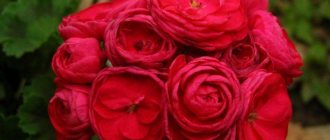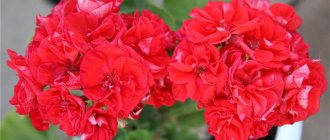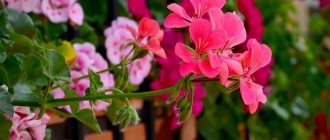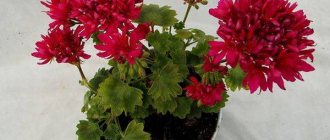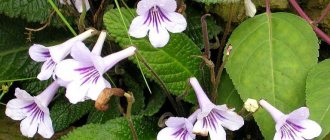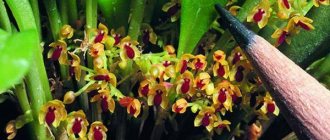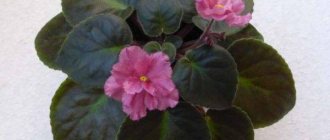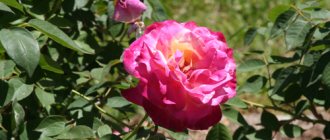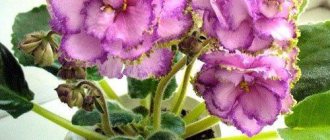Pelargonium PAC Viva - what kind of flower is it
Not everyone knows, but the entire genus Pelargonium belongs to the Geraniaceae family. Perhaps this is why ordinary people often confuse the varieties of these two plants; pelargonium is often called geranium and vice versa.
Pelargonium has excellent decorative properties
The plant, named PAC Viva, is a perennial subshrub that has creeping branches and fleshy foliage. The flowers are on long and powerful peduncles and can have different colors.
Brief description, history of origin or selection
This variety of pelargonium was bred by Swedish breeders. They showed their creation at a European exhibition. The first flower caused a real stir there.
A characteristic feature of the culture is the similarity of its flowers to rose buds. The petals have a terry structure. There may be 6-30 inflorescences on one umbrella. Each flower reaches 5 cm in diameter.
For reference! According to the description, the key advantage of the pelargonium variety PAC Viva is its long flowering.
The plant is compact in size. Its branches fit tightly to each other. The foliage has a hard and rough texture and is dark green in color.
Viva madeline pelargonium photo
Pelargonium Viva are double flowers that literally fascinate with their appearance. This is one of the types of house plants, which is valued for its compactness and long flowering.
In terms of care, the flower is not picky. It is perfect for novice gardeners.
Pelargonium Viva differs from other species in its large flowers, which are similar to ranunculus buttercups.
Knowing the basic rules of plant care, you can grow stunning and fluffy flower beds.
History of origin
Pelargonium blooms abundantly and blooms early. This variety was first presented at the European exhibition in 2011 by the Swedish nursery Rokdala. There the plant created a real sensation, as a result of which Viva pelargonium appeared at an exhibition in Moscow the following year and took prizes in many categories.
External description, features and common types
This variety of pelargonium is completely different from its other types. It resembles heavily doubled Asian ranunculus or red roses.
One inflorescence can form up to 5-30 flowers. Their diameter is 5-6 cm. The flowers in the inflorescence do not fit tightly, so you can see each rose separately.
The growth of a strong peduncle occurs slowly and deliberately. But this shortcoming is compensated by long flowering, which lasts for 2 weeks.
The bush is compact in shape and has good branching. Even without leaf formation, the leaves are dark green in color and hard to the touch. The tips of the leaf blade are in an arc of a deeper green color. If you place the flower in a bright place, it forms lush foliage and a large number of peduncles.
Caroline
This flower produces very delicate lilac-white, densely double flowers. The leaves are dark green and wide. Up to 3-5 buds are formed on one peduncle. Flowering is long and lush.
Madeleine
The variety is characterized by good bush formation and long flowering. The leaves are wide, but small in size. Their color is dark green. The flower belongs to the double zonal subspecies of pelargonium. The color of the flowers is white with a slight pink blush, which forms in the sun.
Rosita
The plant is characterized by bright pink double flowers. Its leaves are green. 5-6 buds are formed on one peduncle. During flowering, which lasts 2 weeks, the flowers are bright and lush.
Get to know the PAK Viva Rosita variety in the photo:
Landing rules
Landing activities are not particularly difficult:
- Start planting from November to mid-spring. The fact is that as the seedlings grow, the duration of daylight hours gradually increases.
- Prepare soil composition for planting. To do this, combine turf, peat, sand in a ratio of 2:1:1.
- Fill the boxes with the resulting substrate. Plant the grains at a distance of 5 cm from each other.
- Sprinkle with earth, but not in a thick layer. Sprinkle with settled water at room temperature.
- Cover the box with plastic and wait for the first shoots, opening the film every day.
Lighting and location
And although many varieties of pelargonium love bright places, Viva has a negative attitude towards the open sun, stagnant heat and overheating of the earthen coma. It is better to grow it on a window facing southwest or east. If possible, with the onset of warm days, move the flower outside.
Soil requirements
Pelargonium Viva is not demanding on the soil, but for abundant flowering and full development, medium-heavy soil with a neutral reaction is required.
How to properly care?
Viva is undemanding in terms of care, but there are a number of requirements:
- Watering. Moisturize pelargonium infrequently. Just make sure its roots don't dry out. To grow a flower, use containers with holes in the bottom. Watering should be done directly from the bottom, then the roots themselves will be able to take the moisture necessary for the plant. Do not use external watering or irrigation, as this can damage the integrity of the leaves and flowers.
- Temperature conditions. For full and comfortable growth of the plant, you need to grow it in a room with a temperature of 20-25 degrees Celsius. If possible, you should take the plant outside.
- Air humidity. Successful cultivation of pelargonium does not allow too much humidity. It should be 65%. Ventilate the room regularly to avoid the development of unpleasant situations.
- Loosening the soil. These activities are required when growing Viva pelargonium. Then oxygen will penetrate into the soil, and water will be able to leave without stagnating in the root system.
- Fertilizer. In spring and summer, during the active flowering of the plant, add special mixtures of nitrogen, potassium and phosphorus to the soil. Such events are held 2 times a month. You can purchase fertilizers in specialized stores.
- Winter care. It is not much different from the standard one. Move the container with the flower to a shaded place where the temperature is 15 degrees Celsius. Water the plant 2 times a month. It is not recommended to feed the pelargonium; it is enough to feed the pelargonium once in the fall.
Source: https://po-lune.ru/viva-madelina-pelargonija-foto/
Photo
Get to know the PAK Viva Rosita variety in the photo:
Common diseases and pests
If agrotechnical rules are violated, diseases arise:
- Fungus Puccinia. It can be recognized by the characteristic red spots on the leaves of the plant. After this, they fall off and the plant dries out. Fungicides are used for treatment.
- Blackleg. This is a bacterial parasite, in the presence of which the stem begins to turn black at the base. If treatment with fungicides is not started in time, the blackening will spread throughout the entire flower.
- Gray rot. This disease can be recognized by the presence of spots and plaque throughout the plant. Most often it forms in poorly heated rooms. For treatment and prevention, it is necessary to create sufficient space for each of the flowers for excellent air ventilation and increase temperature indicators.
- Nematode. This parasite kills the root system, causing the plant to die. The affected flower will have to be thrown away as there is no treatment for this disease.
- Swelling of leaves. This disease is expressed in the form of slight swellings on the leaves. Occurs when there is insufficient lighting and high humidity. To eliminate the disease, change the soil or dry the existing drainage in the pots to remove moisture.
Pelargonium Viva can also be affected by pests:
- aphid;
- caterpillars;
- whitefly;
- termites.
The following drugs are available to combat these parasites:
- Marathon.
- Aspirin.
- Monterey.
- Messenger.
Features of reproduction
The propagation process occurs by cuttings. Ready-made cuttings can be purchased at a nursery or flower market. When planting, do not overwater the flower, otherwise it will die. Propagation by cuttings is carried out in February-March or August-September.
Pelargonium Viva is an ornamental crop that even a child can care for. This flower blooms profusely and luxuriantly both on the balcony and on the windowsill. And in order to prolong this flowering for the maximum period, the task of each gardener comes down to creating adequate growing conditions.
dacha.expert
About the beneficial properties of pelargonium
Homemade varieties of pelargonium are interesting for their varied effects on human bodies. For some, when in close proximity to a flower, the general condition of the body noticeably worsens, while for others, its smell has a relaxing and calming effect.
In addition to decorative properties, pelargonium is also endowed with useful properties: extracts from it are widely used in the perfume industry, as well as to create a variety of medical preparations.
Pelargonium essential oil is added as a flavoring agent in soap making and to create perfumes of very famous brands. The oil is also used to disinfect indoor air. Its aroma does an excellent job of eliminating various microorganisms and purifies oxygen from impurities harmful to the human body.
Pelargonium Pak Viva Rosita
Pelargonium PAC Viva Rosita surprises and fascinates with its beautiful flowers. They resemble buttercups in shape, but have a terry structure and a rich, bright pink color. The variety is rightfully considered a breakthrough in the selection of this type of plant and attracts the attention of both amateur flower growers and more experienced flower collectors.
The pelargonium bush PAC Viva Rosita wins the hearts of flower lovers with its very compact appearance and rich dark green foliage. Against such a contrasting background, its large flowers seem even more beautiful.
Geranium pak viva rosita, a species bred in Sweden in 2011. Made a big splash at one exhibition in Europe. It has similarities with other representatives of the species. Each inflorescence of this type of geranium can have more than 20 flowers with a diameter of about 6 cm.
The flowers are not located tightly to each other, so they are clearly visible. The peduncle is formed quite strong. It develops rather slowly, but the wait for flowering is compensated by a long flowering period, which lasts about 2 weeks.
The formation of the bush occurs independently, without outside intervention. The foliage is rich green and hard to the touch. By placing the shrub in a place with sufficient sunlight, the owner will ultimately receive a plant that will surprise you with the abundance of its foliage and countless honey plants.
Varieties of indoor plants with names and what they look like
Breeders have developed a whole group of varieties of this pelargonium. Each of them has certain advantages.
PAC Viva Madeleine
Pelargonium SOUTH Shukar, Aksinya, Ireland and other varieties
This plant variety is considered the most compact. Pelargonium Viva Madelina is characterized by dark green leaves. The shrub has neat outlines.
Flowering is typical. Pelargonium Madeline is characterized by white inflorescences with a slight pink color.
PAC Viva Carolina
The plant has large buds. They are characterized by a combination of white and lilac shades. The inflorescences have a fleecy texture. Each umbrella contains 5-6 flowers. The leaves are characterized by a typical bright green color.
PAC Viva Rosita
This culture is characterized by deep pink or coral petals. Geranium foliage has a lighter shade. A distinctive feature of the culture is considered to be lush and abundant flowering. Each inflorescence contains 5-7 buds. When they bloom, the culture looks truly luxurious.
PAC Viva Maria
A distinctive feature of the plant is the unusual color of the buds. It is characterized by a combination of white and pink tones. The white color is at the base of the petals; towards the middle it turns pink. The leaves are medium in size and rich green in color.
Important! Flowering lasts 15 days, during which the buds retain a rich shade. At the same time, the plant looks quite neat.
The color of the buds depends on the plant variety
Pac viva madeleine pelargonium description
Pelargonium pak Viva is a plant that simply cannot fail to attract the attention of passers-by. It captivates with its appearance literally at first sight
The main advantage of this flower is its double petals.
Another valuable quality of Viva pelargonium is its ease of care and long flowering time. Some gardeners love this plant for its compactness. Today we’ll talk about detailed care for this beauty.
History of origin and botanical description
The main advantage of the variety is its ability to bloom early, and also bloom for a long time after that. For the first time, a plant of this variety was presented at an exhibition in Europe.
We need to thank the Swedish breeders from the Rokdala nursery for this beauty.
At that event, Viva pelargonium created a real sensation, so already in 2012 it was brought to a competition in Moscow, where the flower won more than one award.
Features of appearance, description and photos of common types
This variety of pelargonium is completely different from its counterparts. It looks more like double Asian buttercup or red roses. One inflorescence can contain from 5 to 30 flowers. Each bud is approximately 5-6 centimeters in diameter.
The buds in each brush do not fit each other very tightly, due to this you can easily examine each flower individually. The peduncle grows quite slowly, but this is further justified by the long flowering period - usually the blooming buds stay on the plant for up to 15 days.
Gardeners like the bush for its compactness. The branches extend from it often and densely. The leaf blades are very dense, even a little harsh, and they are very rich in color - dark green. With a large amount of lighting, the leaves on the plant become even larger and they look more luxurious; with the amount of foliage, the number of peduncles also increases.
We invite you to familiarize yourself with the descriptions and photos of the most common varieties of Viva pelargonium.
Caroline
This plant is distinguished by lilac-white petals. They feel terry to the touch, the flowers grow very densely on the bush. From 3 to 5 single flowers are formed on one flower brush. The leaf blades are, as usual, dark green and differ in their growth in width. The flowering period is considered long, and the process itself occurs very abundantly.
Madeleine
The variety is distinguished by the correct shape of the bush and a long period of budding. The foliage is wide, but we are not talking about large sizes here. The leaf color is dark green. This variety is considered a zonal variety. The shade of the petals is usually white, but blush appears in the sun.
Rosita
Flower petals are bright pink. The foliage is green, but not dark. Approximately 5-6 buds can form on one inflorescence. During the flowering period, which lasts about 15 days, the flowers delight with their brightness and splendor.
How to plant?
This process cannot be called very complicated. The plant should be planted from November to mid-spring. This is due to the fact that as the flower itself grows, the daylight hours must also increase.
Soil preparation
Typically, gardeners purchase a ready-made substrate. It is necessary to buy only soil with neutral acidity levels. However, you can prepare it yourself. To do this, take:
The ratios are maintained at 2:1:1. Mix all this well and fill the container.
- If you are planting cuttings then it should be in a small pot.
- If it is necessary to plant only seeds, then a wooden box is filled with the mixture.
- After this, the grains are placed at a distance of 5 centimeters from each other and lightly sprinkled with soil.
- Then the soil is moistened, but this should be done only by spraying and only with settled water.
- At the end of all procedures, the box is covered with film, which is opened for ventilation daily.
Lighting and location
Despite the fact that pelargoniums usually prefer well-lit places, Viva is a variety that prefers partial shade. To do this, it is better to place a flowerpot with a flower on the western or eastern side of the room.
How to properly care?
Watering mode. It is not necessary to moisten the soil for pelargonium with particular frequency. It is enough just to ensure that the root system does not dry out. Don’t forget about the drainage layer, which will protect the plant from stagnant water; you can also make holes in the bottom of the pot so that excess water drains out even faster.
How to care for PAC Viva at home
Pak Viva Madelina is a pelargonium that needs to be provided with complete and high-quality care for normal development. No special knowledge is required, but there are nuances that need to be studied.
Illumination and temperature conditions
Pelargonium April Snow - growing geraniums
This culture needs not very bright lighting. Florists advise choosing the shady part of the room. In favorable weather, the plant can be taken to the balcony to saturate it with oxygen.
To achieve lush flowering, it is recommended to maintain the temperature at +22..+26 degrees. Windows should be opened periodically to allow fresh air into the room. This will be a reliable prevention of the development of diseases and parasite attacks.
Watering rules and humidity
Too often it is not recommended to moisten the soil, as this provokes rotting of the roots. The soil should be moistened as it dries. There is no need to spray the bushes additionally. This is done only when the air is very dry.
Fertilizing and soil quality
In order for oxygen to flow into the soil better, it needs to be systematically loosened. Active fertilization is required from early spring to late autumn. The necessary compositions are sold in specialized stores and are called “for pelargoniums”.
Flower container size
A medium sized pot is suitable for the plant. It must have drainage holes through which excess moisture will be removed.
Attention! It is best to place the bush on a tray of water. This will help saturate the root system with moisture.
Pruning and replanting
The crop must be pruned annually. In this case, shoots with 4 nodes must be left intact. Thanks to this, you will be able to get a lush plant.
If dry or yellow leaves appear, they should be cut off carefully.
Important! To prevent rotting processes, the cut area should be sprinkled with charcoal. When pruning foliage, the base of the petiole should be left intact.
It is recommended to replant young plants every year. Adult bushes are moved only when the container is full. In this case, you need to place a drainage layer at the bottom and fill the container with turf, peat, humus, and leaf soil. All components are taken in equal proportions.
Pelargonium needs to be pruned in a timely manner
How to properly care?
Watering mode. It is not necessary to moisten the soil for pelargonium with particular frequency.
It is enough just to ensure that the root system does not dry out. Don’t forget about the drainage layer, which will protect the plant from stagnant water; you can also make holes in the bottom of the pot so that excess water drains out even faster. The best way to water is through a tray. This way the rhizomes will receive the required amount of moisture. Experienced gardeners advise completely avoiding watering from above, as well as spraying the leaf plates themselves.- Temperature. The most optimal temperature for Viva pelargonium is 20-25 degrees above zero. It will be great if you can take the plant out into the fresh air during warm weather. It is necessary to monitor the condition of the plant in winter, especially if it is located near a window. It is better to remove it from the windowsill, since being close to cold glass can freeze the entire surface of the flower.
- Air humidity. If you want to grow a healthy and abundantly flowering plant, then make sure that the air humidity is at an average level - it should be approximately 60-65%. Do not forget about constant ventilation of the room, which protects the flower from the development of diseases and pests. There is no need to spray Viva pelargonium. This should be done only during hours of very scorching sun and if the air in the room is very dry.
- Loosening the substrate. This procedure is simply necessary for the normal cultivation of Viva pelargonium. Such manipulations help the soil become more breathable, and excess water in such soil will drain away much more easily.
- Feeding. The plant needs to be fertilized during the active growing season - from early spring to mid-autumn. It is best to purchase ready-made complexes in specialized stores. Make sure that the fertilizer contains nitrogen, potassium and phosphorus in equal quantities. Otherwise, either flowering or growth of green mass will predominate. The fertilizing regime is twice a month. In winter, the plant is not fertilized at all.
- Winter care. This is not to say that it is very different from usual. However, there are some nuances here. The flowerpot with the flower needs to be moved to a darker place, the temperature reduced to +15 degrees. At this temperature and moderate watering, the plant may not enter the wintering period. Moisten the soil much less often - once every two weeks will be enough.
Features of plant flowering
Ampelous pelargonium or geranium - growing and care at home
The plant is distinguished by lush and abundant flowering. It can be used to decorate any room.
- Period of activity and rest
The flowers are on strong peduncles. They have 15-20 buds. Flowering lasts from May to October. After which comes a period of rest. This time is characterized by a slowdown in many processes inside the pelargonium bush, so excess watering and fertilizing will not be beneficial.
- Types and shape of flowers
The flowers are shaped like double peonies or ranunculus. Pelargonium petals are folded in several layers.
Amazingly beautiful pelargonium PAC Viva Rosita
History of the variety
PAC Viva Rosita was first presented at one of the European exhibitions in 2011 by the Swedish nursery Rokdala. Having created a sensation, the variety began its royal march throughout the world. The very next year, PAC Viva Rosita pelargonium won prizes in many categories at the Moscow Flower Exhibition. Definitely, no one remained indifferent to this miracle, and despite the high price, all the cuttings from the plant sold were purchased.
Description of the variety
A completely new flower, unlike other varieties, of this pelargonium resembles the heavily doubled Asian buttercup or Old English red roses. In one inflorescence, from 5 to 30 flowers bloom, often their diameter exceeds 5-6 cm. The flowers in the inflorescence do not fit tightly, which makes it possible to clearly see each miniature rose separately. The strong peduncle grows slowly and unhurriedly, however, the disadvantage is more than compensated by the duration of flowering, which lasts for two weeks.
The bush forms a compact shape and branches well even without formation. The leaves of PAC Viva Rosita are dark green in color and quite hard to the touch. The tip of the leaf blade is in an arc of a more saturated green color. In a bright place it forms a lush mass of foliage and a huge number of peduncles.
Care instructions
Plants of the PAC Viva Rosita variety are recommended to be planted in large containers of 1.5-2 liters in volume, since Rosita’s root system cannot withstand cramped conditions. In smaller pots, the plant slows down, does not bush, and dries out the buds.
Unlike the popular belief that pelargoniums need a sunny place, PAK Viva Rosita (as this variety of pelargonium is called in our country) does not like open sun, stagnant heat and overheating of the earthen coma. A window or loggia facing the southwest or east, but with some shading from the sun's rays, is perfect for her. If possible, with the onset of warm days, move it outside. Under the shade of foliage trees and in the open air, pelargonium PAK Viva Rosita will develop and bloom much better.
The PAC Viva Rosita variety does not tolerate drying at all. When caring for it, watering should be regular and plentiful, especially during the hot summer period. You should especially not allow the substrate to become dry when the plant is in bud. Overdry and you won’t get abundant flowering; Rosita will dry out all the grown buds.
The variety is demanding on fertilizing. It is recommended to alternate organic and mineral fertilizers.
The soil is suitable medium-heavy, neutral reaction.
For propagation, take formed apical cuttings with three leaves and root them immediately in a light substrate. It is often possible to root cuttings in perlite or vermiculite. In water, a cut of pelargonium planting material often rots.
The PAC Viva Rosita variety is suitable for everyone: even beginners will not find it restive, and in the collection of an experienced gardener it will outshine all other plants in beauty.
Growing problems, diseases and pests
If you violate the rules of plant care, there is a risk of the following problems:
- Fungus Puccinia. Red spots on the leaves help identify the disease. Then they fall off and the bush dries up.
- Blackleg. This disease is associated with infection by bacteria. As it develops, the stem turns black near the base. If treatment is not started immediately, the entire flower will suffer.
- Gray rot. With this pathology, the spots affect the entire flower. Most often, the disease develops in heated rooms.
- Swelling of leaves. The pathology is accompanied by the appearance of sagging on the foliage.
As diseases develop, the leaves of the plant darken
Among the pests, pelargonium is attacked by caterpillars, aphids, and termites. There is also a risk of whitefly infestation.
How to deal with them
Fungicidal drugs help control fungi. Insecticides can be used to kill harmful insects.
Pelargonium of this variety has excellent decorative characteristics. To achieve success in growing it, you need to learn how to properly care for the bushes.

